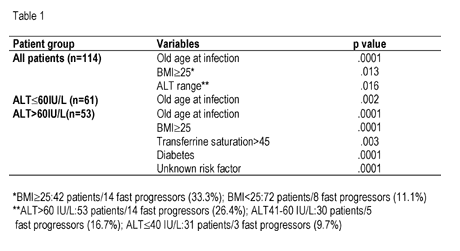 |
 |
 |
| |
|
abstract 215. PREDICTIVE VARIABLES OF HCV-RELATED DISEASE PROGRESSION: NEGATIVE EFFECT OF OVERWEIGHT: diabetes, ALT >60, and weight can have an effect on HCV progression
|
| |
| |
Vicente Ortiz M, Marina Berenguer F, Domingo Carrasco F, Miguel Rayon M, Joaquin Berenguer M, Hosp La FE, Valencia Spain
Background: The natural history of chronic hepatitis C (CHC) is characterized by a wide variability, with progression to cirrosis in approximately 20% of patients within 20-30 years of infection. Identification of variables which may predict an agressive evolution is essential in order to improve patient management, particularly regarding therapy. The aim of this study was to assess the effect of several variables (biochemical, clinical, virological and immunological) in hepatitis C-related disease progression (fibrosis progression rate-FPR- > 0.2 U/year).
Methods: 114 chronic HCV-infected patients (anti-HCV and HCV-RNA positive) were evaluated prospectively between May 2000 and May 2001 (71 % genotype 1b). Fibrosis progression was defined by the annual change in the stage of fibrosis= difference between fibrosis stage in 2 consecutive biopsies divided by the time elapsed between these biopsies when they were available (n=17) or alternatively time between presumed infection (fibrosis 0) and the only biopsy available (n=97).Variables included as potential predictors of outcome included: age, sex, age at infection, history of alcohol intake of more than 5 years (>40g/day in woman and >60g/day in men), risk factor of HCV acquisition (questionnaire), overweight (BMI=weight/height in m2), presence of autoantibodies, iron metabolism (ferritin, transferrin saturation), coexistent diabetes, hyperlipemia, markers of past HBV infection, genotype (Inno-Lipa) and viral load.
Results: of the 114 patients, 22 (19.3%) were considered fast progressors (FPR>0.2U/year). Variables associated with progression by multivariate analysis are shown on table 1. The remaining variables were not predictive of disease progression.
Conclusions: The presence of overweight (BMI=25), old age at infection, and high transaminase levels (> 60IU/l) predict progression to cirrosis in less than 20 years. These results suggest that therapeutical measures aimed at reducing the overweight may play a role in the management of HCV-infected patients, potentially leading to a slower progression of the disease.
Editorial note: as you can see in the table below when ALT is >60 being overweight and having diabetes have a greater effect on HCV progression. |
|
| |
 |
|
| |
|
 |
 |
|
|